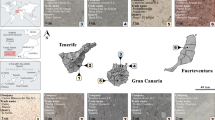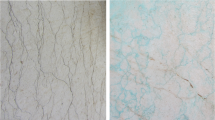Abstract
The stone inlay work on a Mughal mausoleum at Agra in India, dating to the early seventeenth century, was investigated to shed light on its character and composition. Fragments of the different coloured stones used for the inlay were examined by binocular stereoscope and optical polarized light microscopy, and microchemical analysis conducted by scanning electron microscopy with energy dispersive X-ray spectrometry. Two of the five coloured stone varieties present are characterized as bioclastic limestones, while one each is a dolomitic limestone and marble. The last variety is a black coloured stone for which a phyllite and a carbonaceous limestone are shown to have been interchangeably employed. The provenance and decay processes that affect the individual stone types are discussed, and new information on their textural and material composition is brought to notice.



adapted from Uwe Dedering: File:India relief location map.jpg derivative work: User:Milei.vencel, CC BY)








Similar content being viewed by others
References
Ahmad MM (1924) The Taj and its environments, 2nd edn. RG Bansal & Co, Agra
Ahmad AHM, Aquil M (2000) Microfacies Analysis of Kuldhar Limestone, Jaisalmer Formation (Callovian-Oxfordian), Western Rajasthan, India. J King Abdulaziz Univ Mar Sci 12(1):75–88
Anbarasu K (2001) Facies variation and depositional environment of Mesoproterozoic Vindhyan sediments of Chitrakut Area, Central India. J Geol Soc India 58(4):341–350
Asher CB (1992) Architecture of Mughal India. New Cambridge History of India I, 4. Cambridge University Press, Cambridge
Babu Rajeev C (2005) Indian Archaeology 1999–2000: a review. Archaeological Survey of India, New Delhi
Bhattacharayya A, Chanda SK, Friedman GM (1986) Dolomitized glauconite granules: a new kind of peloid from Proterozoic strata of central India. J Sediment Petrol 56(4):480–485
Blakiston JF (1938) Annual report of the archaeological survey of India 1935–36. Archaeological Survey of India, Delhi
Brown P (1964) Indian architecture (Islamic period). Taraporevala Sons & Co Pvt Ltd, Bombay
Carlleyle ACL (1874) Agra. Archaeological Survey of India: Report for the year 1871–72, Delhi. Agra. Superintendent of Government Printing, Calcutta, pp 93–247
Cole HH (1882) Preservation of national monuments: first report of the curator of ancient monuments in India for the year 1881–82. Government Central Branch Press, Simla
Crosthwaite HS (1906) Monograph on stone carving in the united provinces. Government Press, United Provinces, Allahabad
Fábri CL (1936) Annual reports of the archaeological survey of India for the years 1930–31, 1931–32, 1932–33, 1933–34, Part One. Archaeological Survey of India, Delhi
Fergusson J (1876) History of Indian and Eastern architecture. John Murray, London
Ghosh A (1961) Indian archaeology 1960–61: a review. Archaeological Survey of India, New Delhi
Ghosh A (1964) Indian archaeology 1961–62: a review. Archaeological Survey of India, New Delhi
Havell EB (1904) A handbook to Agra and the Taj, Sikandra, Fatehpur-Sikri and the neighbourhood. Longmans Green and Co, London
Heron AM (1953) The geology of Central Rajputana. Memoirs of the geological survey of India, 79. Government of India Press, Calcutta
Jaiswal J (2013) Sedimentological study of the nonclastic rocks of lower Vindhyan around Chitrakoot, India (Banda district, UP) project. MSc (Tech) thesis
Kaur G, Kaur P, Ahuja A et al (2020) Jaisalmer golden limestone: a heritage stone resource from the desert of Western India. Geoheritage 12:53
Khan KBH (1914) Annual progress report of the superintendent, Muhammadan and British Monuments, Northern Circle, for the year ending 31st March 1914. Government Press, United Provinces, Allahabad, pp 28–29
Koch E (2012) The complete Taj Mahal and the riverfront gardens of Agra. Thames and Hudson, London
Krishnan MS (1956) Geology of India and Burma, 3rd edn. Higginbothams (Private) Ltd, Madras
Mahender K, Banerji RK (1990) Petrography, diagenesis and depositional environment of Middle Jurassic Jaisalmer Carbonates, Rajasthan, India. Indian J Earth Sci 17(3–4):194–207
Marshall JH (1904) Archaeological survey of India: annual report 1902–03. Superintendent of Government Printing, Calcutta
McCormack T, The curse of black limestone. https://www.pavingexpert.com/stonpv05. Accessed 12 Nov 2020
Misra RC (2004) Indian archaeology 1998–99: a review. Archaeological Survey of India, New Delhi
Nath R (1989) Colour decoration in Mughal architecture (India and Pakistan). The Historical Research Documentation Programme, Jaipur
Nath R (1994) History of Mughal architecture, vol. III (The transitional phase of colour and design: Jehangir, 1605–1627 A.D.). Abhinav Publications, New Delhi
Okada A, with photographs by Nou JL (2003) A jewel of Mughal India: the Mausoleum of I`timad Ud-Daulah (Ex Oriente Lux Series). 5 Continents, Milan
Paliwal BS, Okada H (1993) Aravalli supergroup of India: an example of the Lower Proterozoic rift tectonics and sedimentation. Journal of the Sedimentological Society of Japan 39:1–14
Pereira D, Tourneur F, Bernáldez L, Blazquez AG (2015) Petit Granit: a Belgian limestone used in heritage, construction and sculpture. Episodes 38(2):85–90
Price MT (2007) Decorative stone: the complete sourcebook. Thames & Hudson, London
Ranawat PS (2005) Can Habur Limestone curdle milk? Curr Sci 89(5):729–730
Roy A, Chakrabarti G, Shome D (2018) Geochemistry of the Neoproterozoic Narji limestone, Cuddapah Basin, Andhra Pradesh, India: implication on palaeoenvironment. Arab J Geosci 11:784
Singh SN, Pal OP (1970) Geology around Chitrakut area, District Banda, U.P. J Palaeontol Soc India 14:77–85
Smith EW (1901) Moghul colour decoration of Agra. Archaeological Survey of India: New Imperial Series 30, Allahabad. pp 18–20
Srivastave N, Ranawat TS (2015) An overview of Yellow Limestone deposits of the Jaisalmer Basin, Rajasthan. India Volumina Jurassica 13(1):107–112
Vikrama B (2011) Stone inlay work in Agra monuments and its restoration. ACCU NARA International Correspondent, The Eight Regular Report, pp 10–13
Voysey H (1825) On the building stones and mosaic of Akberabad or Agra. Asiatic Researches 15:429–435
Watson J (1916) British and foreign marbles and other decorative stones. University Press, Cambridge [Eng]
Acknowledgements
The authors are grateful to the Archaeological Survey of India (ASI) for according the necessary permissions for this study, and to the Science Branch of the ASI at Agra for assisting in the analyses. Ruth Siddall is much thanked for providing kind comments on examining the mounted samples. The World Monuments Fund (WMF) is gratefully acknowledged for providing financial support to make this work possible.
Author information
Authors and Affiliations
Corresponding author
Additional information
Publisher’s note
Springer Nature remains neutral with regard to jurisdictional claims in published maps and institutional affiliations.
Rights and permissions
About this article
Cite this article
Gill, M.S., Bhatnagar, M.K. Examination of Mughal stone inlay work on the mausoleum of I’timad-ud-Daulah, Agra, India. Archaeol Anthropol Sci 13, 221 (2021). https://doi.org/10.1007/s12520-021-01454-6
Received:
Accepted:
Published:
DOI: https://doi.org/10.1007/s12520-021-01454-6




